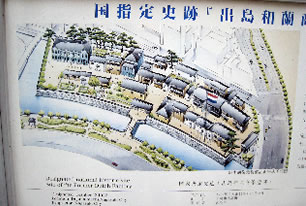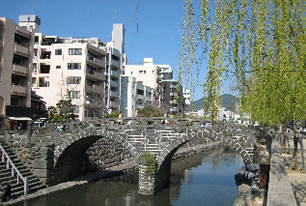Articles on Japan, Links & Reviews
Travel in Japan
Travel to Nagasaki - Dispatch from Nagasaki, Japan (Part 2)
A Travel Journal
The City and Europeans
Nagasaki was Japan’s only official window on the world from 1639 when foreigners were banned except for a Dutch enclave on Dejima, a "man-made" island in Nagasaki harbour. Built by local officials and businessmen, Dejima was leased to the Dutch after the expulsion of the Catholic Portuguese in 1639. Dutch wives and children were prohibited, making for a steady flow of courtesans across the only bridge. Other Japanese allowed on Dejima included artisans, traders, and the ever-present officials. The island remained the only European settlement in Japan until the "Amity" Treaty of 1858, thanks to Commodore Perry and the Kanagawa Convention of 1854.
Dejima was named a national historic site in 1922 and in 1996 Nagasaki City launched a restoration campaign and has largely reconstructed the buildings. Still an active archeological site, Dejima is visitor friendly and a short walk or tram ride from downtown hotels. In addition to period European furniture, table settings, and clothing, displays include paintings by Japanese artists giving us some idea of living arrangements, life styles and commercial activities of the Dutch. We can only guess what the Japanese initially thought of these non-bathing, red meat eating, hard-drinking barbarians.
Notwithstanding whatever initial culture clash might have existed, the Dutch enclave provided an important conduit in the exchange of goods and ideas. Dutch physicians are credited with introducing western scientific thought including western medicine, training local doctors over the course of the 200 years of Japan’s isolation. These ways of thinking were transmitted to other parts of Japan through the Dutch Factor’s annual visit to Edo (Tokyo) with gifts of books as well as commercial products and exotic animals.
With the opening of Japan in 1859, Europeans descended on Nagasaki and the foreign quarter expanded from Dejima into the city proper and up the slopes to the east. This area became known as Hollander Slopes as all Europeans were called "Hollanders". British (especially Scots) traders and industrialists played important roles in expanding trade, helping Japan industrialize, and even supporting political forces in overthrowing the shogunate, restoring the Imperial Family to its former prominence.
Most remarkable was a young Scot by the name of Thomas Glover who arrived in Nagasaki at the age of 21. He built a trading and industrial empire with Japanese partners and became an advisor to the Japanese government in its quest to modernize. Significantly, he is the founder of the Japan Brewery Co. Ltd. that later became Kirin Brewery, the largest in Japan today. The mascot still bears the trademark Glover moustache. So who knew it was a Scot?
In my quest to find the origins of beer in Japan, I had boiled it down to either the Dutch who imported beer from breweries outside Japan or Germans who discovered hops naturally growing in Hokkaido and set up their own cottage production. Some claim an American started the first brewery in 1870. True or not, what we know for sure is that it was a Scot who brought beer to the masses. The Glover property is now a historical site situated on Hollander Slopes overlooking Nagasaki Harbour and containing a number of European houses in addition to the old Glover residence. Other European historic sites on Hollander Slopes are also preserved and easily accessed. There is English signage throughout the area.
Nagasaki is well worth the visit. Historical significance combined with an agreeable climate, beautiful setting, and a compact downtown with a rejuvenated waterfront make it a desirable destination. Most sites are within walking distance of downtown hotels and the Atomic Bomb Museum is a short tram ride away (100 yen or $1.00 CDN). Like all Japanese cities, Nagasaki has some great restaurants with a cuisine notable for its Chinese and European influences. We particularly liked the Nill Style Café and its sunken garden not too far from Spectacles Bridge, reputedly the oldest stone bridge in Japan. The pasta is spectacular.
We stayed at the Comfort Hotel Nagasaki, part of a chain of modestly priced business hotels, for 8500 yen ($85.00 CDN) a night for two, taxes and breakfast included.
Rick Beardsley, a retired teacher, lives in Richmond, Canada.

* Dejima Schematic

* Spectacles Bridge
More information on Nagasaki
Wikipedia - Nagasaki
Nagasaki City Website
Nagasaki Prefectural Tourism Federation
Nagasaki City Tourism Website
Getting There
By air:
From Tokyo: 1 hour and 40 minutes
From Osaka: 55 minutes
From Nagoya: 1 hour and 20 minutes
*Shuttle bus from Nagasaki Airport: 40 minutes
JAL - Japan Airlines
ANA Sky Web
By rail:
(JR limited express train)
From Fukuoka: Approximately 1 hour and 50 minutes
* Fukuoka (Hakata) is the main Shinkansen station for the Kyushu Region.
JR (Japan Rail) Kyushu
JR West
JR East
For more detailed access information, please visit: Nagasaki - Access
Nagasaki Hotels
Comfort Inn Nagasaki
From 5,500 Yen per night (includes breakfast)
http://www.choice-hotels.jp/nagasaki/
Hotel Monterey Nagasaki
From 7,200 Yen per night (includes breakfast)
Hotel Monterey Nagasaki (English)
In addition to Japan's Premier Shop Directory, English OK! offers the following services:
Customer Service English Training: Onsite Workshops, e-Learning & Books
Multilingual Website Design